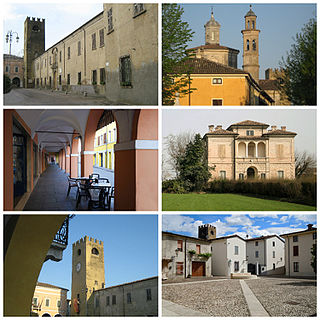
Castel Goffredo is a comune (municipality) in the province of Mantua, in Lombardy, northern Italy, 35 kilometres (22 mi) from Mantua and a few more from Brescia. It lies in a region of springs at the foot of the slopes that drain into Lake Garda, towards the plain of the Po. Castel Goffredo borders the following municipalities: Castiglione delle Stiviere, Medole, Ceresara, Casaloldo, Asola, Acquafredda, Carpenedolo.

Lorenzo Leonbruno, also known as Lorenzo de Leombeni, was an Italian painter during the early Renaissance period. He was born in Mantua (Mantova), an Italian commune in Lombardy, Italy. Leonbruno is most well known for being commissioned by the court of Francesco Gonzaga, Marquis of Mantua, and his wife Isabella d'Este. The patronage continued with their eldest son Federico II Gonzaga, who was the fifth Marquis of Mantua. Leonbruno was the court painter for the Gonzaga family from 1506–24.

The Marquisate or Margraviate of Mantua was a margraviate centered around the city of Mantua in Lombardy. Ruled by the Gonzaga family from its founding in 1433, it would later be raised to the rank of Duchy in 1530.
Gasparo Antonio Turbini was an Italian architect and Jesuit priest, mainly active in a Neoclassical-style in the Province of Brescia, Italy.

Costante Tencalla was a Swiss-Italian architect and sculptor.

Aloisio Gonzaga was an Italian condottiero.

Palazzo Gonzaga-Acerbi is a historic palace in Castel Goffredo in the Province of Mantua in Italy.

The Castello di San Giorgio is part of the Ducal palace of Mantua. It is a moated rectangular castle, each of which's four corners has a large tower and the moat is crossed by three drawbridges.

Castel Goffredo Town Hall and Loggia della Magnifica Comunità are located in Piazza Mazzini in Castel Goffredo, in the Province of Mantua (Italy). It is the seat of the municipality.

The history of Castel Goffredo, an Italian municipality located in Upper Mantua on the border with the province of Brescia, began in the first half of the 3rd millennium B.C., although the present town was founded in Roman times and then developed over the following centuries. In the early medieval period the history of the city was closely linked to the control of the powerful families of the Visconti, Della Scala and the Republic of Venice. However, the city's history remains inextricably linked to the Gonzaga, who ruled it for 400 years. An autonomous fief from 1444 to 1602 under the first marquis Alessandro Gonzaga, it was at this town, in 1511 with Aloisio Gonzaga, that the collateral branches of the "Gonzaga of Castel Goffredo, Castiglione and Solferino" and the minor branch of the "Gonzaga of Castel Goffredo" originated, which died out in 1593. Castel Goffredo became one of the historic Gonzaga capitals, the forerunner of other small capitals from Castiglione to Sabbioneta, due to its urban layout of 1480, equipped with a strict orthogonal grid. With the advent of Napoleon, the town was part of the Cisalpine Republic and, after its fall, of the Kingdom of Lombardy-Venetia; in 1861 it was finally united to the Kingdom of Italy, following its subsequent historical events.
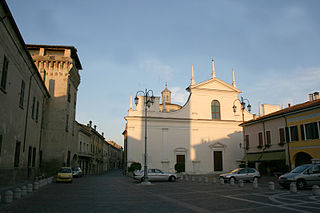
Piazza Mazzini is a public square in the center of Castel Goffredo, region of Lombardy, Italy.

Castelvecchio is the ancient fortified village of Castel Goffredo, in the province of Mantua Lombardy region in Italy, surrounded by walls and a moat. The boundaries currently correspond to the garden of the Palazzo Gonzaga-Acerbi to the north, to vicolo Remoto and vicolo Cannone to the east, to Piazza Mazzini to the south and to piazzetta Castelvecchio and vicolo Castelvecchio to the west.

The Arese are a prominent family of the Milanese nobility.
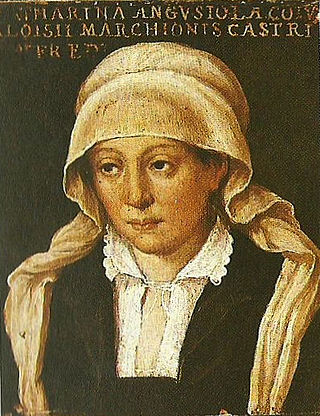
Caterina Anguissola Trivulzio was an Italian noblewoman.
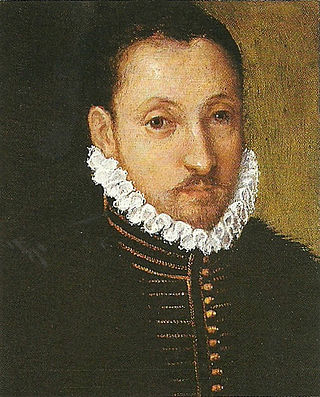
Ferrante or Ferdinando Gonzaga, first marquess of Castiglione was an Italian nobleman and condottiero.
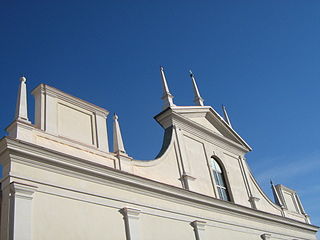
Sant'Erasmo is a Roman Catholic church located in Castel Goffredo, region of Lombardy, Italy.
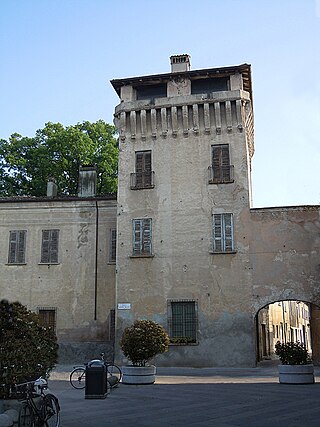
The Torrazzo is a historic building in Castel Goffredo, in the province of Mantua.

Upper Mantua is a geographical area located northwest of the city of Mantua in the province of the same name and bordering the provinces of Brescia and Verona, bordered to the north by the morainic hills of Lake Garda, to the east by the province of Verona, to the northwest by the province of Brescia, and to the south by the plains of Middle Mantua.




















